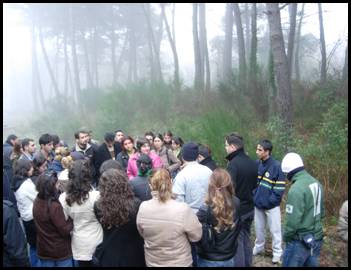
THE
BIOGEOGRAPHER
Newsletter of the Biogeography Specialty
Group of the Association of American Geographers
Electronic Version; Special Catch-Up Edition Volume
6 No. 2 Spring 2006 & Volume 7 No. 1 Fall 2006
BSG Executive Board
Joy Nystrom Mast (President), Carthage College
Mary Ann Cunningham Vassar College; David Cairns, Texas A&M
University;
Charles Lafon, Texas A&M University; Jim Speer, Indiana State
University
Taly Drezner (Secretary-Treasurer), University of Wisconsin-Milwaukee;
Duane Griffin (Editor), Bucknell University
|
|
|
Greetings fellow biogeographers and thanks to the many who attended the 2006 Annual Biogeography Specialty Group business meeting in Chicago. Currently, the BSG is one of the largest specialty groups in the AAG with ca. 500 members. The BSG wishes to thank outgoing board members David Cairns and Mary Ann Cunningham for their two years of service, and welcome new board members Catherine Yansa and Rosemary Sherriff and re-elected student representative Chad Lane. I want to share with you all the highlights of the BSG for 2005 and gather input for 2006.
In 2005, the Biogeography Specialty Group focused on outreach to the biogeography community. First, we revived the BSG website. The new site is housed through South Carolina run by John Kupfer (http://people.cas.sc.edu/kupfer/bsg.html). At this website your can find links to The Biogeographer: The Official Newsletter of the BSG run by Duane Griffin, current and past officers, awards and competitions (Henry Cowles Award for Excellence in Publication, James J. Parsons Distinguished Career Award, Competition, and the Graduate Student Paper Competition). The new BSG website also includes a link to the International Biogeography Society, including the announcement for the 2007 IBS Meeting in the Canary Islands. Second, we established a new BSG listservs (BSG-AAG@listserv.utk.edu) through the University of Kentucky run by Henri Grissino-Mayer. Third, we increased student involvement and support in the BSG. We added a BSG board position for a student, and funded this student representative ($500) to cover attendance at the national AAG meetings. We created a student BSG listserv for students only, currently run by Chad Lane (see website to join). We increased student funding for grants ($1000 and $500) and presentation awards ($200 each), as well as added a best poster award ($100). Chad Lane, the current BSG student representative on the board, organized a special BSG-sponsored session on employment as a biogeographer at the Chicago meeting. Fourth, we organized many venues for interactions at the annual AAG meeting, including sponsoring thirty-five sessions, organizing a behind-the-scenes tour of the Field Museum led by Ken Young, hosting a very well attended BSG social at the Exchequer Pub following our annual business meeting, and contributing to the physical geography reception party at the Palmer House.
For 2006, we would like to continue the mission of the Biogeography Specialty Group by promoting interactions between biogeographers, stimulating active research and teaching development in biogeography, and facilitating the exchange of ideas. To this end, the BSG board is open to suggestions for programs and ways to fulfill our mission. To get the ball rolling, I am suggesting we create a link on the BSG website for biogeography teaching material, particularly syllabi. To help organized this effort, I will serve as the contact person to put the teaching material together for a link on the BSG website. To contribute, send an e-mail with your introductory biogeography syllabus (word document or html) attached to jmast@carthage.edu. Feel free to also send any other biogeography teaching materials you wish to share with the BSG community, such as labs, powerpoints, and case studies, as well as other “advanced” biogeography courses syllabi and materials. By seeing how other biogeographers are teaching the introductory class, we can generate ideas and discussions on important themes and provide new biogeography professors a valuable resource for organizing their own courses. Please consider sending me a quick e-mail with your biogeography syllabus attached, and then enjoy seeing how your fellow members teach at their institutions. Thanks in advance for your input and help.
Joy Nystrom Mast, BSG President
2005-07
Minutes of the Annual Meeting of the Biogeography Specialty Group, Association of American Geographers, March 8, 2006, Chicago, IL
Submitted by Taly Drezner, Secretary-Treasurer
Welcome
Joy Mast, President of the BSG, opened the meeting at 7:05pm. She noted
that the BSG has over 500 members and is one of the top specialty
groups in terms of number of members.
New Website
Joy Mast thanked John Kupfer for taking care of the official AAG-BSG
webpage, including housing syllabi online for biogeography courses. The
website is: http://people.cas.sc.edu/kupfer/bsg.html
New Listserv
Joy Mast thanked Henri Grissino-Mayer for hosting our listserv. The
listserv is:
BSG-AAG@LISTSERV.UTK.EDU.
New Graduate Representative
Joy thanked Chad Lane for his service and for getting the BSG student
listserv up and running. Graduate students that wish to be added may
email him. Joy noted that Chad also did a great job putting together
today's employment session and other special sessions focusing on
student issues for the AAG meeting. Let Chad know if you have any ideas
for sessions for next year. Also be sure to submit any articles or
additions for the newsletter.
Newsletter
Joy thanked Editor Duane Griffin for all of his work on the BSG
newsletter. Duane asked that any materials of interest to be sent to
him to add to the newsletter. Duane and Joy both thanked Publications
Editor Henri Grissino-Mayer for compiling recent publications for the
newsletter, which now appears in every issue. Duane will be away next
fall and a volunteer to guest editor is wanted. Henri will also help,
so send references and publications to him. Also, there is still room
in the spring newsletter, if you have any submissions.
Cowles Award
Joy thanked Mary Ann Cunningham for organizing, as both thanked the
judges. Mary Ann reminded the attendees to submit papers for next
year’s competition as folks read papers. She then presented the 2006
Henry Cowles Excellence in Publishing award in Biogeography, given to
Kathryn Alftine and George Malanson for their recent paper published in
the Journal of Vegetation Science, entitled, “Directional
Positive Feedback and Pattern at an Alpine Tree Line.” Congratulations
Kathryn and George! A plaque was given to George Malanson, and a second
plaque will be sent to Kathryn. George thanked the committee and the
Biogeography Specialty Group, and also noted that the project was part
of a larger group project, for which he also thanks D. Cairns, D.
Butler, and M. Becker. This paper was recognized as one of the best
papers of the year in the Journal of Vegetation Science.
Student Research Grant Awards
Joy thanked Charles Lafon for organizing, and both thanked all nine
judges. Charles presented the winners, noting that there were many good
research proposals. The two winners were announced and offered
congratulations:
Masters: Ranya Henson of the University of Hawaii ($500)
Ph.D.: Scott Markwith of the University of Georgia ($1000)
Student Presentation Awards
Joy thanked Jim Speer for organizing, and thanks to all of the judges.
This year’s winners could not be announced since judging was still in
progress, with 2 M.A. and 8 Ph.D. contenders. Jim presented winners
from last year’s competition:
Masters: C. Kolden of the University of Nevada, Reno
Ph.D.: J. Sibold of the University of Colorado, Boulder
Scott Mensing accepted the award for C. Kolden in her absence.
BSG Elections
Joy thanked David Cairns for organizing the election. David announced
the winners:
Two new board members: Rosemary Sherriff (University of Hawaii, Hilo)
and Katherine Yansa (Michigan State University), replacing David and
Mary Ann Cunningham.
Graduate student rep: Chad Lane, University of Tennessee was reelected
to his second and final term.
David reminded the group to please vote, and congratulations to all of
the winners!
BSG Finances – Treasurer’s Report
Joy thanked Taly Drezner for serving as BSG Treasurer. Taly gave the
treasurer’s report (attached),
and noted that the BSG membership brought in $2820 in the most recent
12 months for which we have completed records. Taly also informed the
group about new changes voted upon by the board in their meeting prior
to the present specialty group business meeting, specifically, changes
to awards and funding. The funding for the student research grant
awards, starting this year, will be raised to $1000 for the Ph.D. and
$500 for the Masters. The best M.A. and Ph.D. presentations will be
increased to $200 each. In addition, the BSG will provide $500 to the
graduate student representative on the board for support for travel to
the AAG annual meeting. Although there were no competitors this year,
the new best student poster winner will receive $100.
BSG Sponsored Sessions
This year, 35 sessions were sponsored or co-sponsored by the BSG.
Members are encouraged to come up with ideas for sessions for next
year’s meeting in San Francisco, as well as any field trip ideas.
BSG Field Trip
Joy thanked Ken Young for organizing the 2006 field trip, “Fieldwork! A
Behind-the-Scenes Tour of the Field Museum’s Biodiversity Programs” on
Friday, from 9am to noon.
BSG Social
Following the business meeting, Joy invited all members to meet at the
Exchecquer Pub and Restaurant, at 226 S. Wabash Avenue (and E. Adams)
only one block from the conference hotel.
Physical Geographers Reception
The annual physical geography party was held Friday night, from
8-midnight in the Monroe of the conference hotel. Joy invited all
biogeographers to attend. The BSG has co-sponsored this event.
Discussion for BSG
Joy asks BSG members to share their hopes for the future of the
specialty group and their concerns. She asks how might we move into new
growth and better serve our membership. The board is open to hearing
what you think!
Journal of Mountain Science
Donald Friend announced that a new journal (named the Journal of
Mountain Science) dedicated to research on mountains has been
started by the Chinese Academy of Science and submissions are
encouraged, particularly from international scientists.
Quaternary Specialty Group
Rob Dull suggested starting a new specialty group dedicated to
Quaternary Science. There were already two sessions at this meeting and
many biogeographers were involved. Rob questioned whether this would
fracture the BSG, though he thought it would facilitate discussion and
people would be equally involved.
Position for Biogeographer at the University of the West
Indies (in Jamaica)
Chad Lane announced an opening for a biogeographer in the U. of the
West Indies and they have received no applications! He said he will put
this on the BSG listserv.
San Francisco Annual Meeting
Scott Mensing announced that he is a co-chair for the arrangements in
next year’s meeting in San Francisco. He asked if anyone has any field
trip ideas or ideas for sessions, organizing sessions, etc., to let him
know.
New Ph.D. Program at the University of Nevada, Reno
Scott Mensing announced that a new Ph.D. program was just approved and
the department is taking applications for the Fall of 2007. He brought
fliers for interested parties.
International Biogeography Society
Duane Griffin promoted attendance to the International Biogeography
Society in January 4 – 7, 2007 in Tenerife, in the Canary Islands. The
last meeting was in West Virginia and was very good. This is an
excellent organization, made up primarily of biologists, and a few
British geographers. North American geographers are notably
underrepresented, despite Glen MacDonald from UCLA being instrumental
in getting it going.
New Physical Geography Biogeography Editor
George Malanson informed the group that he is the new biogeography
editor of Physical Geography, replacing Al Parker who stepped
down. The journal is seen by many people and has a good turn around
time, and George encourages submissions.
North American Dendroecology Fieldweek
Jim Speer announced the one-week dendroecology fieldweek, which covers
everything from fieldwork to presentation. This is an NSF funded
program, so now there is support for undergraduates (3) as well as some
international awards.
CDAG Meeting
Amy Hessl of West Virginia University is hosting CDAG in Morgantown and
encourages attendance.
GSA Meeting
Sally Horn announced (in place of Katherine Yansa who was unable to
attend) the upcoming GSA meeting, in which Katherine is organizing a
paleoenvironment session. If you are interested, let Katherine know and
you can be invited to the special session.
Adjournment
The meeting was adjourned to the Exchecquer Restaurant and Pub at 7:35
pm.
The Cowles Award, established in 1998, honors Henry Cowles, whose
Presidential Address, “Causes of Vegetation Cycles” was the first paper
published in the AAG Annals
(1911). The award is to be given annually in recognition of the best
biogeographical publication of the year, honoring either books or
papers. This year's award winner is particularly in keeping with
Cowles's original theme. The BSG is pleased to honor Kathryn Alftine
and George Malanson of the University of Iowa for their paper
"Directional positive feedback and pattern at an alpine tree line" (Journal
of Vegetation Science Vol. 15, pages 3–12).
Abstract
The spatial pattern at alpine tree line may be part of a feedback
process in which wind plays a central role. The basic aspects of such a
feedback were embedded in a cellular automaton. Spatial metrics of the
patterns generated by this simulation and those of observed patterns at
a windy tree line site were ordinated using Principal Component
Analysis. Only the simulations that included a directionally weighted
feedback fell close to the observed sites in ordination space. MANOVA
indicated that the directionally weighted feedback is most important in
structuring the tree line pattern, but that random hotspots for
establishment and the overall steepness of the environmental gradient
from forest to tundra in space also have an effect. The importance of
wind in determining feedback with the spatial pattern of a canopy
indicates that non-linear reactions to climatic change are likely.
Congratulations Kathryn and George!
2006
BSG Student Awards
As always, sumbissions
for the 2006 BSG Student Paper and Research Grant competitions were of
extremely high quality, and a great deal of hand-wringing went into the
award decisions. The four winning papers and projects are particularly
interesting in that they represent cutting-edge work in biogeography
that are, nonetheless, firmly grounded in geographical biogeography's
traditional core concerns and linkages to the broader field of physical
geography. The future of the subdiscipline looks bright indeed!
MS
Paper Competition
Winner
Abstract:
The effects of earthworms (order Oligochaeta) on pedogenesis, nutrient
cycling, and vegetation dynamics are recognized to be substantial and
often detrimental to forest health. These effects are most pronounced
in previously worm-free areas, where Oligochaetes can alter forest
dynamics by blending soil profiles. These effects are most noticeable
in glaciated regions where native Oligochaetes are rare or absent but
non-native species have been introduced. To assess the status of
introduced species in Yukon Territory, Canada, I made a preliminary
survey of the region and analyzed dispersal trends using field samples
and informal interviews/surveys conducted throughout Summer 2005. All
individuals found were in the capital city of Whitehorse, of the
species Eisenia foetida (red wiggler or manure worm). Anecdotal
evidence suggests they are distributed for vermicomposting as well as
through imported soils. It was found that they are anthropochores with
ranges restricted to areas modified by humans. It was hypothesized that
these non-native species are limited to urban areas in southern Yukon,
similar to patterns shown in studies done elsewhere. As a
surface-dwelling epigeic species, Eisenia foetida has little potential
for significantly altering soil profiles. At the time of fieldwork it
was also determined that this Lumbricid species does not present an
immediate invasional threat due to minimal urbanization, climate
restrictions, and slow natural colonization rates. Various climate
amelioration scenarios, however, suggest that dispersal and fecundity
of other Lumbricids may increase in coming years. The currently
worm-free forests of the Yukon may therefore experience dramatic change
as non-native Oligochaetes become established.
PhD Paper
Competition Winner
Kevin John Anchukaitis (University
of Arizona) for his paper Calibrating
annual isotope chronologies in Ocotea
tenera (Lauraceae) from the Monteverde Cloud Forest, Costa Rica
co-authored with Michael N Evans (University of Arizona),
Nathaniel T Wheelwright (Bowdoin College), and Daniel P Schrag (Harvard
University)
Abstract
In temperate regions, networks of tree-ring chronologies provides
proxies for paleoclimatic analysis. Many tropical trees do not form
reliably annual rings, making it difficult to develop chronologies in
these regions. We seek to establish high-resolution proxy paleoclimate
records from trees without annual rings using stable isotope
dendroclimatology. We apply our protocols to trees from the Monteverde
Cloud Forest, where changes in ecology and hydrometeorology are related
to variability in the tropical ocean-atmosphere system and climate
change. Because they are associated with specific hydroclimatic
conditions, cloud forests may be particularly sensitive to climate
variability and change, such that proxy records from these sites record
the behavior of the tropical ocean-atmosphere system. The calibration
of an age model for trees without rings is a prerequisite for
paleoclimate reconstructions. Our approach uses microsampling, rapid
cellulose preparation, and CFIRMS to identify isotope cycles in wood
which are associated with the change in the delta-18O of
water sources used by trees over a year. Trees of known age and growth
increment were sampled in plantation sites to test our age model.
High-resolution stable isotope measurements reveal coherent delta-18O
cycles up to 10 permil. The growth rates derived from the isotope
timeseries match those from measurements. These data support our
hypothesis that isotope cycles can be used to provide chronological
control in the absence of rings. The ability of trees to record
interannual climate variability is evaluated using the isotope signal
from multiple trees and sites, and meteorological and climate field
data for well-observed warm ENSO events.
Thanks to James
Speer
2006 BSG Student Research
Grants
The MS Research Grant goes
to Ranya
Henson (University of Hawaii), $500 for her study, Genetic Structure in the Hawaiian
Intertidal Zone: Space, Scale and
Disturbance. (Click here for
Ranya's project proposal)
The Ph.D. Research Grant
winner is Scott Markwith
(University of Georgia), $1000 for his project, Application of Hydrologic Modeling for
Investigating Hydrochory in the Aquatic
Macrophyte Hymenocallis coronaria. (Click here for
Scott's project proposal)
Congratulations Ranya and Scott!
Thanks to Charles Lafon
As many of you know as the graduate student representative for the Biogeography Specialty Group (BSG) I was responsible for arranging a special session for student members of the BSG at the annual meeting of the Association of American Geographers (AAG) in Chicago this year. After speaking to my colleagues here at the University of Tennessee and colleagues from other institutions, it quickly became apparent that the best topic for this session would be employment as a biogeographer. In my humble opinion, the panel session was a great success and I sincerely thank everyone involved! Panel members included Dr. Karen Arabas, Dr. Matt Beaty, Dr. Glen MacDonald, Dr. Kimberly Medley, Dr. Shelly Rayback, and Dr. Jim Speer.
The session included very insightful discussions between the audience and the panel regarding preparation for employment as biogeographer, avenues of employment in the field of biogeography, and tips on excelling as a professional biogeographer. In particular, the discussion revolved around the diversity of job opportunities available to biogeographers preparing to enter the workforce. Drs. Kimberly Medly and Matt Beaty did a fantastic job of outlining opportunities that are available to biogeographers who would like to work with non-profit organizations, non-governmental organizations, and government agencies. Dr. Glen MacDonald offered the valuable perspective of a department head who has been involved with hiring numerous faculty members at the University of California-Los Angeles, a top research oriented institution. Drs. Karen Arabas, Shelly Rayback, and Jim Speer offered insight into teaching and conducting research at smaller, teaching-oriented institutions.
In my opinion, the biggest message to come out of the discussion was that students should not rush into any one particular rigid career path unless they are sure it is their desired professional path. All of the panelists urged students to take their time and explore the many employment opportunities available to them such as internships and temporary positions with non-profit organizations, non-governmental agencies, and governmental agencies. The panelists stressed the importance and the advantages of getting into these very extensive social networks, which can often land you a more permanent position.
For those students that have already decided that they would like to become professionals in the world of academia the panel offered several suggestions. Beyond the obvious suggestion of building a strong CV with solid publications, grants, and teaching experience, the panel also suggested that students be very patient. The hiring process in academia is very unpredictable and a flawless CV is not always enough to get you the job you most desire. Academic positions typically come with very specific requirements, like particular specializations or geographic regions of interest, which may not be your focus. In addition, Dr. Glen MacDonald made the point that even if you do get invited for interviews with a very strong CV, you are more likely to lose the job during the interview than get it. In other words, do not lean on your CV to get you the job, be sure that you are familiar with the department in which you are interviewing and can sell yourself (by being prepared to explain how you are the best person for the job no matter the perspective of the interviewer) to every member of that department on an individual basis. This must have struck home with several of the attending students because a request was made that we hold mock job interviews at the annual meeting next year in San Francisco (please let me know if you would like for this to happen and I will try and organize something).
In the end, the message coming through from the panelists seemed to be, don’t rush into any rigid career path you are not absolutely sure you want to be a part of, work hard, make lots of connections, and most importantly, be patient with the opportunities that become available to you. The panelists seemed very confident that taking this approach would maximize your chances of obtaining a job as a biogeographer in any one of a myriad of different settings.
If you have any ideas for a special session at next year’s AAG meeting in San Francisco please let me know ASAP. So far, I have had requests for a session regarding job interviews, a session regarding grant opportunities available to graduate students, or maybe even another employment session like the one we held in Chicago. If you have an idea for a special session, please e-mail me at clane6@utk.edu and I’ll see what I can do!
Chad Lane, Grad Student Rep, 2005-2007
Student members of the Biogeography Specialty Group with interests in tropical organisms and habitats may be interested in a new offer from the Association of Tropical Biology. The ATB is now offering free online subscriptions to Biotropica to students. Although it is possible to download articles from this journal from many libraries, often it is not possible to get the last year or two of issues. So the online subscription could be quite helpful even to students whose University libraries subscribe to Biotropica. And undoutedly it will be helpful to students who have no library access to the journal.
(If you are on the editorial board of a journal, perhaps you would want to consider asking that journal to follow Biotropica's lead in making journals available online to students).
Here is the announcement from the recent "Tropinet" newsletter:
FREE BIOTROPICA ONLINE
For the first time, Biotropica is offering free online subscriptions for all students. This gives you rapid internet access to the journal (but not the other advantages of ATBC membership, such as receiving hard copies of Biotropica, free page charges for publications, and discounts for annual meetings). The free student memberships are valid for three years.
To receive free online access, send your name, full institutional address, email address, and proof of your status as a student (either a photocopy of your current student ID or a signed letter from your thesis advisor or another department member) to:
Membership Services, Blackwell Publishing Inc.
350 Main Street, Malden, MA 02148, USA
For almost instant access, send the information by fax: (+1 781 388 8232) or as an email attachment to membershipservices@blackwellpublishing.com
Sally Horn, Department of Geography, The University of Tennessee
International Biogeography Society
The 3rd biennial conference of IBS will be held 9-13 January 2007 on the island of Tenerife, Canary Islands. The main focal point of IBS meetings are plenary symposia on specific topics, which are augmented by poster sessions, workshops, and field trips. The past two meetings have been fantastic. For more information, visit the IBS web site.
Membership in the IBS is $40 ($30 for students) and, in addition to supporting the society, provides three benefits: 1) reduced cost of registration fees to attend IBS conferences, 2) discounts (up to 20%) on books published in association with IBS, and 3) free online access to Blackwell Publishing's three biogeography journals: Journal of Biogeography, Global Ecology & Biogeography, and Diversity & Distributions, three journals covering all aspects of biogeography and ecology, and 4) 20% discount on additional Blackwell Publishing journals Oikos, Ecography, and Journal of Avian Biology.
For more information on the society, visit the IBS home page.
Robert G. Bailey
USDA Forest Service
Rocky Mountain Research Station
Abstract
Ecoregion maps show the earth’s surface subdivided into identifiable
areas based on macroscale patters of ecosystems. These ecoregions
delimit large areas within which local ecosystems recur more of less
throughout the region in a predictable pattern. For example, trees are
found on north-facing slopes throughout the semi-arid mountains of the
American West. This presentation summarizes the rationale I used in
identifying ecoregion boundaries on maps of the United States, North
America, and the world’s continents. The geographic reasoning used in
drawing boundaries involves 20 principles, which are presented to
stimulate discussion and further understanding. (Click here
for the full pdf document.)
Course Notes
Istanbul University Field Trip to Lake Terkos,
February 4, 2006
Meral Avci
Istanbul University
Department of Geography
 |
The diversity of Istanbul and its surrounding is profound from a biogeographical point of view. Lake Terkos, located northwest of Istanbul, is an important drinking water source, and is surrounded primarily by deciduous forests, shrublands, wetlands and coastal dunes. This is one of the most important plant diversity areas in Turkey, supporting 575 taxa. It is also an important area for bird diversity. |
|
The Terkos forests are managed under a
traditional system for timber harvest and charcoal production, which
provides income for some villages in the area (foto: Near Karamanli
village).
|
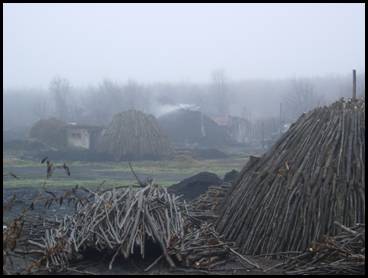 |
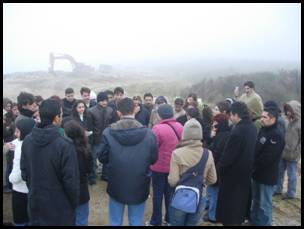 |
Lake Terkos is a lagoon. Coastal dune vegetation is present on the barrier beach where it is possible to find endemic and precious dune plants. However, a dune-stabilization afforestion campaign begun by the French in 1885–1887 and continued by Turkish Ministry of Forest from 1960s onward introduced exotic species such as Acer negundo, Pinus maritima, Robinia pseudoacacia and Cytisus scoparius. Istanbul University undergraduate and graduate students examined sites and debated these issues on the field trip. |
Field Notes
Fieldwork! A Behind-the-Scenes Tour of the
The field trip was entitled “Fieldwork! A Behind-the-Scenes Tour of
the
As background, the Field Museum of Chicago was founded in 1893 and works to increase scientific knowledge and awareness through their anthropology, botany, geology, and zoology collections and exhibits.
The “behind-the-scenes” part of the tour was able to examine the challenges in managing information about biological diversity, making it available in useful forms, while maintaining the original specimens for future generations.
The visit began among the bird collections, with explanations on how specimens are maintained and what kinds of research are being done with them. Collections manager David Willard is shown in these pictures demonstrating a bird of paradise (Figure 1), a passenger pigeon (Figure 2), an ivory billed woodpecker (Figure 3), and how skeletons are cleaned and preserved for later study (Figure 4).
|
Figure 1.
Examining a bird of paradise in the bird
collections.
|
Figure
2. The bird collections include extinct species, such as this passenger
pigeon.
|
The group then heard about the local and international programs for
biodiversity conservation, which are located in the Division of
Environment, Culture, and Conservation of the
|
Figure 3. Dave Willard, the
bird collections manager, talks of stalking evidence of the
ivory-billed woodpecker (shown here) in the swamps of Arkansas
|
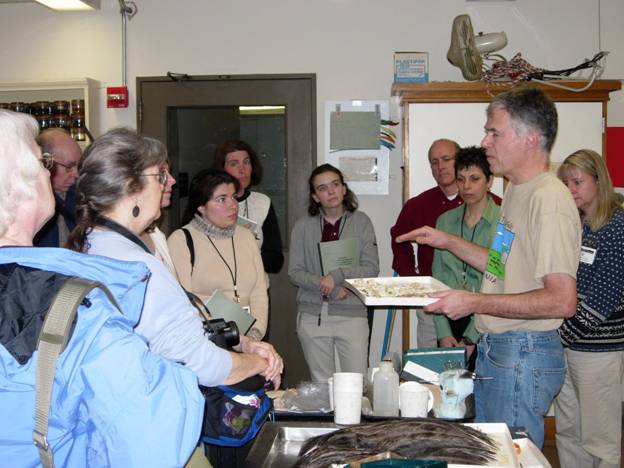 Figure 4. The bird specimens
are processed and stored as study skins, skeletons, and as tissues to
be used for genetic analyses.
|
Robin Foster described the ECP’s international programs, including the use of satellite imagery and field trips by multi-disciplinary teams to evaluate biological diversity and its surrounding social and legal context in isolated “wilderness” areas of the tropics and subtropics. Many of the places their teams have surveyed (Figure 5) have later been made into conservation protection areas, some managed by national governments, some by conservation nongovernmental organizations, and still others by indigenous groups.
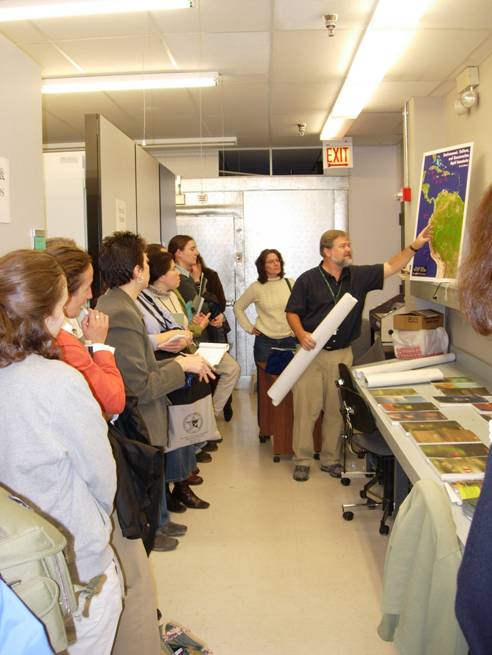 Figure 5. Robin Foster
explaining how
priority areas are chosen for conservation efforts in the tropics of
the world.
|
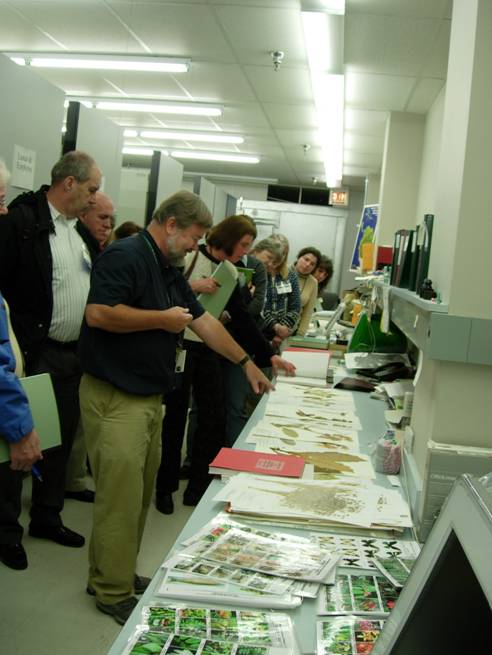 Figure 6. Plant
specimens and colorful photographs made into field guides are some of
the materials maintained and distributed through Field Museum programs.
|
He also demonstrated how plant specimens stored in the herbarium are being scanned so that they are accessible through the web. In addition, he has designed a series of “quick guides” that allow for the rapid identification of plants and other organisms through colorful photographs (Figure 6). Christine Niezgoda then described the goals and functioning of the main herbarium, with its several million plant specimens and a mandate to maintain those collections for the future while providing access to interested researchers. The final message to the visitors came from Edna Davion, from Academic Affairs of the Field Museum, who mentioned the world-class collections also to be found in the museum for mammals, reptiles and amphibians, fishes, invertebrates, and many kinds of fossils, not to mention the non-biodiversity strengths of research in geology and anthropology.
Throughout the trip, it was clear that there are many possible roles
for biogeographers to participate in the
investigation and subsequent communication about biodiversity as
represented in the materials stored in natural history museums,
particularly as their staff and curators attempt to use that
biodiversity information to help with conservation planning decisions.
On August 29,
Hurricane Katrina made landfall near the Mississippi-Louisiana border
with sustained wind speeds of ca. 125 mph and a storm surge that
exceeded 25-30 feet and penetrated more than 3 miles inland in some
places. Rainfall rates exceeded 1 inch/hour across a large area of the
Gulf Coast, and precipitation analysis from NOAA's
Climate Prediction Center show that rainfall accumulations exceeded
8-10 inches along and to the east of the hurricane’s track. Peak wind
gusts of 100 mph and sustained hurricane force winds persisted nearly
100 miles inland, resulting in widespread damage as far as Hattiesburg
and Laurel, MS. In terms of forest damage, preliminary estimates were
that Katrina damaged or destroyed ca. 19 billion board feet of timber
with an estimated value of roughly $5 billion on five million acres in
Mississippi, Alabama and Louisiana. Forest inventories indicate that
nearly 90 % of all damaged forestland was < 60 miles from the coast,
and one-third of the timber damaged was concentrated in 8 counties in
southern Mississippi. For example, estimates of damage on the DeSoto Ranger District of the
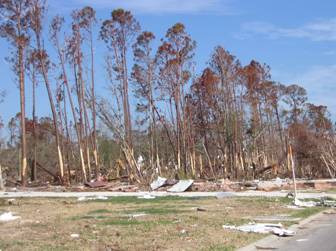 |
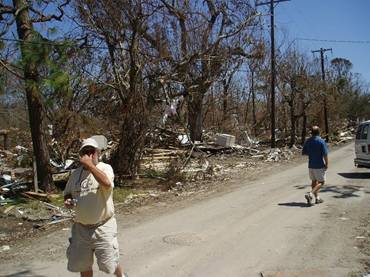 |
| Pine damage resulting from the effects of storm
surge and salt spray near |
Chair of the Southern Miss Geography Department and “closet biogeographer” Skeeter Dixon takes a quick break from helping out with forest sampling near Pass Christian, MS |
Ecologically, post-hurricane forest recovery is a function of the effects of the hurricane on the preexisting community coupled with a range of factors determining the community’s response to newly imposed environmental conditions. To clarify how forest ecosystems in southern Mississippi were affected by Katrina and how they are likely to respond, John Kupfer (Univ. of South Carolina) and colleagues Scott Franklin and Reza Pezeshki (Dept. of Biology, Univ, of Memphis) initiated a multi-scale study that incorporates field-based research, greenhouse studies and remote sensing. Much of their work thus far has focused on documenting and contrasting damage inside and outside of the storm surge zone around St. Louis Bay, MS, including repeat sampling of soils to assess changes in soil properties such as salinity, nutrient status, and redox potential. Also, as part of a graduate seminar that John is teaching at USC this spring, he took 10 graduate students to conduct assessments of forest damage patterns in coastal Mississippi, with a particular focus on assessing controls of damage at scales ranging from trees and stands to entire landscapes. This research, funded initially by a Rapid Response grant through the Coastal Resiliency Information Systems Initiative for the Southeast (CRISIS) program, is expected to continue throughout the next several years.
Karen B. Arabas
Arabas, K.B., Hadley, K.S., and Larson, E.R. 2006. Fire history of a
naturally fragmented landscape in central Oregon. Canadian Journal
of Forest Research 36: 1108–1120.
Meral Avci
Avci, M. 2005. Diversity and endemism in Turkey vegetation. Ýstanbul
Üniversitesi Edebiyat Fakültesi Coðrafya
Bölümü Coðrafya Dergisi 13: 27–55 (in Turkish,
with English abstract).
Henri D. Grissino-Mayer
Grissino-Mayer, H.D., DeWeese, G.G., and Williams, D.A. 2005. Tree-ring
dating of the Karr-Koussevitzky double bass: A case study in
dendromusicology. Tree-Ring Research 61(2): 77–86.
Keith S. Hadley
Frenzen, P.M., Hadley, K.S., Major, J., Weber, M.H., Franklin, J.F.,
Hardison, J., and Stanton, S. 2005. Geomorphic change and vegetation
development on the Muddy River mudflows. Pp. 75–91. In: Dale, V.H.,
Swanson, F., and Crisafulli, C.(eds.). Ecological Recovery of
Mount St. Helens after the 1980 Eruption. Springer-Verlag, New
York.
Weber, M.H., Hadley, K.S., Frenzen, P.M., and Franklin, J.F. 2006.
Forest succession following mudflow burial, Mount St. Helens,
Washington. Canadian Journal of Forest Research 36: 437–449.
John Kupfer
Kupfer, J.A. 2006. National assessments of forest fragmentation
patterns in the U.S. Global Environmental Change A - Human and
Policy Dimensions 16: 73–82.
Kupfer, J.A., Malanson, G.P. and Franklin, S.B. 2006. Not seeing the
ocean for the islands: The influence of matrix-based processes on
forest fragmentation effects. Global Ecology and Biogeography
15: 8–20.
Kipfmueller, K.F. and Kupfer, J.A. 2005. Complexity of successional
pathways in subalpine forests of the Selway-Bitterroot Wilderness Area,
USA. Annals of the Association of American Geographers 95:
495–510.
Yi-Chen Wang
Wang, Y-C. 2005. Presettlement land survey records of vegetation:
geographic characteristics, quality and modes of analysis. Progress
in Physical Geography 29: 568-598.
Wang, Y-C. and Larsen, C.P.S. 2006. Do coarse resolution U.S.
presettlement land survey records adequately represent the spatial
pattern of individual tree species? Landscape Ecology 21:
1003-1017
If you read the business meeting minutes closely, you'll notice that we were looking for a guest editor for the fall 2006 edition of The Biogeographer, and that I was still accepting materials for the spring edition, which was running late. In the absence of a volunteer for substitute editor, and swamped by duties as co-director of Bucknell's London program, I decided I'd settle for a single combined 2006 edition, which I'd try to edit over the summer or pull together with help from Joy Mast and Henri Grissino-Mayer by long distance. In retrospect, both plans were laughably ambitious, and we went sans newsletter for 2006, until now. Thanks to the new mailing list system that Joy Mast initiated and to John Kupfer's diligent webmastering, I don't think the BSG has suffered my absence. We should be back on schedule now, with the spring '07 edition scheduled to go live in early April.
One item that does seem to have fallen through the cracks is Joy's effort to create a web repository of syllabi and other biogeography teaching materials, as described in her president's column. John has created a link and page, but at this point, it isn't populated. This is a great idea that deserves our support. Please contribute links to your syllabus and materials you've developed for teaching biogeography.
Duane A. Griffin
Editor, The Biogeographer
Dept. of Geography
Bucknell University
Lewisburg, PA 17837 USA
Ph. 570/577-3374
dgriffin @ bucknell.edu